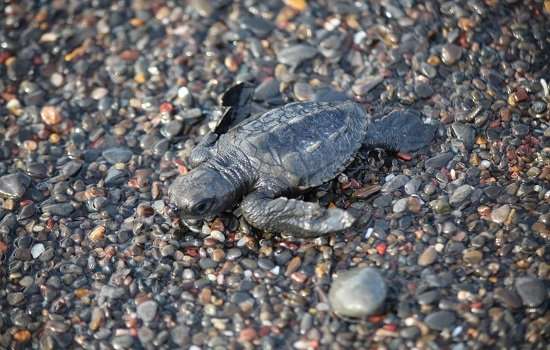Masterchef technique found to be a lifesaver for endangered sea turtle eggs

Monash University scientists have made the unlikely discovery that a popular Masterchef technique can protect the eggs of endangered sea turtles during transport.
The researchers have found that cheap and readily-available vacuum bags provide the right oxygen-free environment to transport eggs when they are relocated to protect them from poaching, erosion or inundation. The discovery is highlighted in a recent study published in Biological Conservation.
Sea turtles are charismatic species and a focus of major conservation efforts around the world.
"They spend most of their life at sea but return to land to lay eggs, so conservation is often concentrated on protecting clutches of eggs from poachers, predation or tidal inundation at nesting beaches," said Associate Professor Richard Reina, the study senior author from the Monash School of Biological Sciences.
"Turtle eggs usually die if they are moved after a certain stage of development.
"But our new technique will help reduce these deaths when researchers and conservationists relocate turtle nests."
Researchers collected and tested 303 eggs from nesting at Playa Ostional, Costa Rica to complete the study.
The study's lead author, PhD student Sean Williamson said given the frequency, and predicted increase of egg transportation for research and conservation, it is important that the process is efficient and safe.
"The practice of egg relocation for many reptiles (including all turtles and crocodiles) comes with the risk of movement-induced mortality of the embryo," he said.
"Low-oxygen pauses turtle embryonic development, which protects them from movement-induced death.
"Our technique is based on our research investigating how oxygen controls the way turtle embryos develop."
Embryos always pause development whilst in the mother's oviducts due to low levels of oxygen. After the eggs are laid, the exposure to oxygen in the air causes the embryo to start developing again.
However, the researchers found that if they kept the eggs in low oxygen they were protected from mortality caused by movement.
"Drawing inspiration from cooking techniques, we found that vacuum-sealed bags are an effective way of placing eggs in a low-oxygen environment that keeps them paused and allows them to be transported," Associate Professor Reina said.
"The technique is cheap and can easily be done at remote nesting beaches with a simple hand-pump used to remove the air from the bags."
The scientific paper describing the work is free to access from the journal Biological Conservation until December 2017.
More information: Sean A. Williamson et al. Hypoxia as a novel method for preventing movement-induced mortality during translocation of turtle eggs, Biological Conservation (2017). DOI: 10.1016/j.biocon.2017.10.009
Journal information: Biological Conservation
Provided by Monash University



















